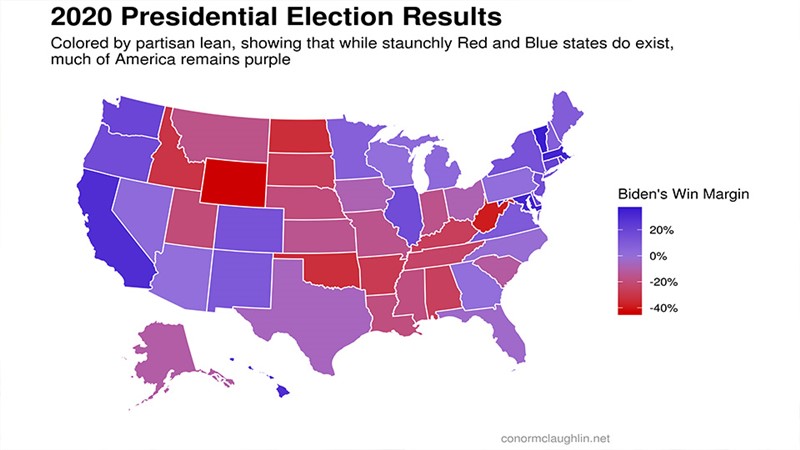2022.11 The Taiwan Banker NO.155 / By Matthew Fulco
Purple America is more politically important than everBanker's Digest
States that are neither reliably Republican nor Democrat will be crucial in determining the winners of the upcoming midterms and the 2022 presidential electionPolitical polarization has increased considerably in the United States since the 2000 presidential election, when the terms “red states” and “blue states” were adopted to describe whether voters in a particular state tended to support Republican Party or Democratic Party candidates. It is hard to imagine certain reliably red/Republican states, such as Alabama, Wyoming and Kansas, giving their electoral votes to a Democratic presidential candidate. Similarly, it is just as difficult to envision blue/Democratic California, New York and Illinois voting for the Republican candidate. One of the main reasons red states have become “redder” since the 1990s is that white working-class voters that make up large segments of those states’ populations have shifted decisively to the Republican Party. As recently as the 1990s, large numbers of such voters still supported the Democratic Party in states such as Arkansas, Louisiana and Tennessee. Bill Clinton won those three southern states in both the 1992 and 1996 presidential elections. However, since then, those states have become deep red, voting for the Republican candidate in every election since 2000 by a wide margin. Meanwhile, blue states that have become “bluer” include Oregon, Washington, Colorado and New Mexico. The former three states are home to growing numbers of educated urban professionals in the major metropolitan areas of Portland, Seattle and Denver respectively. New Mexico, meanwhile, is home to a large Hispanic population that leans Democratic. Broadly speaking, the more rural and whiter a state’s population, the more likely it is to be deep red, while more urbanized and racially diverse states usually have bluer populations. The five reddest states in America as measured by partisan voting index are Wyoming, West Virginia, North Dakota, Oklahoma and Idaho, while the five bluest include Vermont, Hawaii, Massachusetts, Maryland and California. Vermont is unusual in that it is deep blue but very rural. The Electoral College and importance of purple states Unlike most other representative democracies, the United States does not directly elect the president and vice president through the popular vote. Instead, it has a process called the Electoral College that comes from the Constitution, a compromise between a popular vote by citizens and a vote in Congress. Each state has as many electors as it does members of Congress (House and Senate). There are currently 538 electors in total. 270 electoral votes are needed to win a presidential election. While a candidate must win the most popular votes in a given state to be awarded that state’s electoral votes, it is still possible to win an election by amassing more overall electoral than popular votes. Republicans George W. Bush and Donald Trump both lost the popular vote and still won the 2000 and 2016 elections, respectively. Since 2000, a handful of “swing states” or “purple states” (a combination of red and blue) have been decisive in determining the winner of close presidential elections. In 2000, it came down to Florida, in 2004 Ohio, 2016 Pennsylvania, Michigan and Wisconsin and in 2020 the latter three states as well as Georgia and Arizona. Georgia and Arizona were once reliably red states, but have become purple due to demographic changes, as has Virginia. The growth of large communities of educated professionals in the major metropolitan areas of these states – Atlanta, Phoenix, Richmond and nearby Washington DC – has caused them to turn from red to purple. To be sure, the rural parts of these states still vote overwhelmingly Republican, but that can be offset by the population advantages of their large metropolitan areas. While the demographic changes in these three states have been to the advantage of Democrats, Republicans have benefited from a different set of changes in Ohio and Florida, which together have 47 electoral votes (17 and 30 respectively), more than the 40 combined electoral votes of the three swing states won by Democrats in 2020. Ohio was considered a purple state until 2020, but has gradually shifted to the right. It has a significant population of working-class voters who tend to vote Republican, even more so than since Donald Trump’s victory in 2016. In Florida’s case, Democrats have been lackluster in grassroots politics for decades. They have not controlled both houses of the state legislature since 1997. Democrats have been further marginalized by the state’s popular Republican Governor Ron DeSantis, a longtime Trump ally. Midterm elections forecast Purple states will play a decisive role in this this year’s midterm elections, which are shaping up to be unlike most in recent memory. Of the seven toss-up states that will likely decide control of the Senate, not one is reliably red or blue. Typically in midterm elections, U.S. voters punish the party in power by handing control of Congress to the opposition. Midterms tend to bring out unhappy but energized voters, who send a message of dissatisfaction by voting against the party of the president. To that end, since 1932, the opposition party has gained seats in the House of Representatives in every midterm election except for 1998 and 2002. For the incumbent party, holding control of the Senate would be considered a satisfactory result in a midterm election. Of the two chambers of Congress, it is the more powerful, and without control of both, the opposition party has limited capability to enact its legislative agenda. In 2018, the most recent midterm election, Democrats won the House but failed to wrest control of the Senate from Republicans. Thus, they had power to push back against the Republicans’ agenda, but not to pass legislation of their own. This year, Democrats are forecast to hold the Senate – it is currently at 50-50 with Vice President Kamala Harris holding the tie-breaking vote – but lose the House. The Economist’s latest forecast shows the Democrats winning an average of 51.2 Senate seats and the Republicans 221.6 seats in the House. 218 are needed for a majority in the House. Just a few months ago, Republicans were predicted to handily win both chambers of Congress. With President Joe Biden’s approval rating hovering around 40%, it was hard to see Democrats holding onto either the House or the Senate. But then the Supreme Court overturned its 1973 decision granting women the constitutional right to an abortion. While popular with conservatives, this ruling does not sit well with the majority of voters, and it has energized left-leaning Democrats, especially women. They are now more likely to turn out for the midterms than before. Still, that may not be enough to prevent the Republicans from winning the House. After all, while the U.S. economy has avoided a recession for now, inflation remains stubbornly high. Inflation for the 12 months ended August 2022 was 8.3%, the highest level in three decades. For most voters, persistently rising prices of household goods are a bigger problem than abortion rights. The 2024 presidential election Though the 2024 presidential election is more than two years away, it can be safely said that a handful of purple states will once again decide the winner. It will not matter whether Donald Trump or someone else is the Republican presidential candidate. The same swing states will decide the election. Some observers lament that a small group of states seems to have such disproportionate power to decide the country’s leaders. But in some ways these states that are neither reliably conservative nor liberal may more accurately represent the median American voter than solid red or blue states. If we assume that both Ohio and Florida have become reliably Republican states, then in 2024 the Republicans would start with 219 electoral votes and the Democrats 226. The Democrats could win the election by the narrowest of margins, reaching 270 electoral votes, just by winning Pennsylvania, Wisconsin and Michigan, which they have in every presidential election since 1988 save the 2016 contest. The Republicans could reach 270 if they won North Carolina’s 16 electoral votes (likely), plus Georgia, Arizona and one of the midwestern states. Of course, there might be a surprise, with a previously reliably red or blue state “flipping” to the other side. This is exactly what happened with Georgia and Arizona in 2020. For the Republicans, the most likely blue state to flip would be Minnesota, which Joe Biden carried by a margin of 7.12% in 2020 and Hillary Clinton by just 1.52% in 2016. For Democrats – and this would be a long shot – the state to flip would be Texas. Donald Trump won it by a margin of just 5.58% in 2020. With 40 electoral votes, Texas is a huge prize, and if Democrats won it, they most likely would win the 2024 election by a wide margin. However, the last Democrat to win Texas in a presidential election was Jimmy Carter in 1976. Texas remains a long shot for Democrats, and it will be more important for them to focus on winning historically blue Pennsylvania, Michigan and Wisconsin if they want to remain in the White House for another four years.


